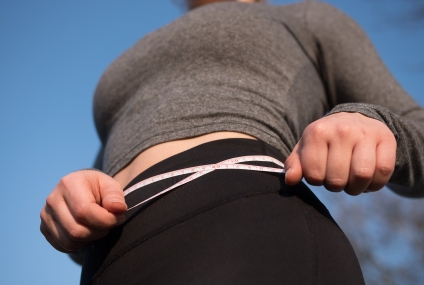How I Lost 20 Pounds Through Mindfulness

“Your body can stand almost anything. It’s your mind that you have to convince.”
I ballooned up to 202 pounds earlier this year and couldn’t stand it. I had weighed about 182 for most of my adult life, and felt comfortable at that weight. As a professional speaker and author, I felt it was important for me to “walk my talk,” every minute of the day.
As I began the regular practice of mindfulness meditation, my ability to resist over-eating became stronger, and my tendency to eat late at night diminished. It’s not as if losing 20 pounds was the focus of my meditation: it wasn’t. What happened was that through meditation, I was able to maintain a clearer focus on what I wanted, and how fit I could be.
Embody the Message
To optimally influence others, I decided to embody the message that I was verbally disseminating. If people were to believe me as a speaker, I needed to show up in the present as someone who looked like he was in personal control. Here is what embodying the message I wished to impart meant for me:
- Maintaining my ideal weight of 182 pounds.
- Wearing no watch. If I have appointments I simply make sure I’m near a timepiece.
- Staying off most mailing lists, except for the few that matter.
- Pausing for at least ten minutes each day to stop, collect my thoughts, and take a deep breath.
- Recognizing that a walk outdoors, talking to a good friend, reading, and other activities are more rewarding than staring at screens.
- Keeping letters and correspondence to one page if practical.
- Doing one thing at a time: I don’t eat while I read, doodle while I talk on the phone, or give divided attention while in conversation.
Rationalizing Leads to Ineffectiveness
As I began speaking to more groups via webinars during the Covid-19 lockdown, working from my home office, it might have become easy for me to rationalize over-eating. Instead, I envisioned the “new, slim me.”
While becoming more adept at webinars, I had to devise a plan for staying fit while stuck at home, and to not experience hunger cravings, resort to diet pills, or make extreme sacrifices. In the present, in real time, I would honor my weight and fitness related goals.
Here’s a brief description of the action steps that enabled me to stay in shape, and have more energy day in and day out:
1. Do some kind of exercise every day. I learned a valuable tip from a friend who is trim and toned. He makes it a rule to exercise at least some portion of each day, even if only a 15 minute walk around the block.
Some exercising each day is not just a good idea, it becomes a challenge for you to find ways to work out in confined areas. Suppose in the future you’re stuck in a small city, in a hotel without athletic facilities, and there’s a thundering rainstorm outside. The test becomes using the hotel’s hallways, or even your own hotel room as your gym.
2. Use my living room as a health club. It is easy enough to jog in place while watching TV, and to bend, stretch, and lift weights. Walking up and down stairs is excellent exercise that gives you a good workout to muscles in your back, derriere, and legs.
When it comes to television, definitely workout while you watch. Run in place, do arm circles, or squats. If you’ve ever taken an aerobics class, you know a variety of exercises you can do in a four-foot square space.
3. Walk around the block. In many neighborhoods, a couple times around the block will give you 15 minutes of solid walking. If you’re near a supermarket or neighborhood shopping center, or better yet a large shopping mall, you can easily spend an hour walking up and down the aisles and hallways. Don’t stop to look at the goods; your goal is to stay in motion.
4. Break the cycle. When you work out vigorously for hours on end like many people in health clubs do, you fall into a cycle that’s hard to undo:
- Dehydration, so you fill up on water
- Hunger, so you fill up on food
- Weariness, so you get a lot of rest
You wake up the next day hungry and thirsty again, and can end up overeating as a result of your vigorous workouts. When you simply walk, do calisthenics in front of the TV, or pursue other methods of light exercising, you never face the dehydration, hunger, and tiredness cycle. I was able to drop 20 pounds with no hunger cravings whatsoever, and without tiredness. It felt natural, it was relatively easy, and now I don’t know how I ever let myself balloon up to 202 pounds.
With my new-found energy, I began playing basketball again. All my clothes fit, people routinely mistake me for someone several years younger than I am, and I felt great.
Need help learning mindfulness meditation? Check out Mindfulness Meditation Made Simple: Your Guide to Finding True Inner peace (paperback).
Mindfully Master Your Goal
Your goal is to pick something you wish to mindfully master and create measures for proceeding now, as your day and life unfold. Based on the measures that you choose, and the particular circumstances of your life, your plan will be different from someone else’s. The plan will work best if you can implement a part of it everyday. Here are some reinforcement techniques:
- Seek others with goals similar to yours.
- Post reinforcing statements and reminders in view.
- Record affirming statements on your phone.
- Take bite-size action steps.
- Have someone waiting to hear of your progress.
- Envision yourself succeeding.
- Plot your plan on the calendar starting from the end date.
- Build in some flexibility.
There are people who actually live in the present moment. They can open the mail and deal with it when it arrives, respond to phone calls when they come, and depart from work each evening at a reasonable hour. People who live in the present have a life after work, and take regular vacations. There’s no reason why you can’t be one of them.
About the Author

Jeff Davidson, the world’s only holder of the title “The Work-Life Balance Expert®” as awarded by the U.S. Patent and Trademark Office, is the premier thought leader on work-life balance issues. Jeff speaks to organizations that seek to enhance their overall productivity by improving the work-life balance of their people. He is the author of Everyday Project Management, Breathing Space, and Simpler Living. Visit BreathingSpace.com.
If you enjoyed this article, sign up below for the Blooming Lotus Newsletter and we’ll notify you when the next article is released:





0 Comments